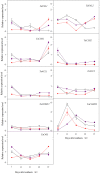Accumulation of Phenolic Compounds and Expression Profiles of Phenolic Acid Biosynthesis-Related Genes in Developing Grains of White, Purple, and Red Wheat
- PMID: 27148345
- PMCID: PMC4840273
- DOI: 10.3389/fpls.2016.00528
Accumulation of Phenolic Compounds and Expression Profiles of Phenolic Acid Biosynthesis-Related Genes in Developing Grains of White, Purple, and Red Wheat
Abstract
Polyphenols in whole grain wheat have potential health benefits, but little is known about the expression patterns of phenolic acid biosynthesis genes and the accumulation of phenolic acid compounds in different-colored wheat grains. We found that purple wheat varieties had the highest total phenolic content (TPC) and antioxidant activity. Among phenolic acid compounds, bound ferulic acid, vanillic, and caffeic acid levels were significantly higher in purple wheat than in white and red wheat, while total soluble phenolic acid, soluble ferulic acid, and vanillic acid levels were significantly higher in purple and red wheat than in white wheat. Ferulic acid and syringic acid levels peaked at 14 days after anthesis (DAA), whereas p-coumaric acid and caffeic acid levels peaked at 7 DAA, and vanillic acid levels gradually increased during grain filling and peaked near ripeness (35 DAA). Nine phenolic acid biosynthesis pathway genes (TaPAL1, TaPAL2, TaC3H1, TaC3H2, TaC4H, Ta4CL1, Ta4CL2, TaCOMT1, and TaCOMT2) exhibited three distinct expression patterns during grain filling, which may be related to the different phenolic acids levels. White wheat had higher phenolic acid contents and relatively high gene expression at the early stage, while purple wheat had the highest phenolic acid contents and gene expression levels at later stages. These results suggest that the expression of phenolic acid biosynthesis genes may be closely related to phenolic acids accumulation.
Keywords: different-colored grains; gene expression; phenolic acid accumulation; wheat.
Figures

 ,
,  , and
, and  stand for white wheat Yumai49-198, red wheatYangmai22 and purple wheat Zhouheimail, respectively. Panels (A–F) stand for ferulic acid, vanillic acid, p-coumaric acid, syringic acid, total phenolic acid, and caffeic acid, respectively.
stand for white wheat Yumai49-198, red wheatYangmai22 and purple wheat Zhouheimail, respectively. Panels (A–F) stand for ferulic acid, vanillic acid, p-coumaric acid, syringic acid, total phenolic acid, and caffeic acid, respectively.
 ,
,  , and
, and  stand for white wheat Yumai49-198, red wheat Yangmai22, and purple wheat Zhouheimail, respectively.
stand for white wheat Yumai49-198, red wheat Yangmai22, and purple wheat Zhouheimail, respectively.
Similar articles
-
Identification and Antioxidant Properties of Phenolic Compounds during Production of Bread from Purple Wheat Grains.Molecules. 2015 Aug 26;20(9):15525-49. doi: 10.3390/molecules200915525. Molecules. 2015. PMID: 26343616 Free PMC article.
-
Antioxidant Capacity and Profiles of Phenolic Acids in Various Genotypes of Purple Wheat.Foods. 2022 Aug 20;11(16):2515. doi: 10.3390/foods11162515. Foods. 2022. PMID: 36010514 Free PMC article.
-
Genotype and environmental variation in phenolic content, phenolic acid composition, and antioxidant activity of hard spring wheat.J Agric Food Chem. 2006 Feb 22;54(4):1265-70. doi: 10.1021/jf052683d. J Agric Food Chem. 2006. PMID: 16478246
-
Unrevealing the mechanisms behind the cardioprotective effect of wheat polyphenolics.Arch Toxicol. 2024 Nov;98(11):3543-3567. doi: 10.1007/s00204-024-03850-y. Epub 2024 Aug 31. Arch Toxicol. 2024. PMID: 39215839 Review.
-
Review of the Sensory and Physico-Chemical Properties of Red and White Wheat: Which Makes the Best Whole Grain?Foods. 2020 Jan 28;9(2):136. doi: 10.3390/foods9020136. Foods. 2020. PMID: 32012822 Free PMC article. Review.
Cited by
-
Physiological and Metabolic Responses of Wheat (Triticum aestivum L.) after One-Generation Exposure to Perfluorooctanesulfonic Acid (PFOS).ACS Agric Sci Technol. 2025 Mar 7;5(4):593-602. doi: 10.1021/acsagscitech.4c00722. eCollection 2025 Apr 21. ACS Agric Sci Technol. 2025. PMID: 40276683 Free PMC article.
-
Metabolomics Revealed the Differential Metabolites of Different Broomcorn Millet Varieties in Shanxi.Food Sci Nutr. 2025 Sep 3;13(9):e70902. doi: 10.1002/fsn3.70902. eCollection 2025 Sep. Food Sci Nutr. 2025. PMID: 40909253 Free PMC article.
-
Anthocyanins in Whole Grain Cereals and Their Potential Effect on Health.Nutrients. 2020 Sep 24;12(10):2922. doi: 10.3390/nu12102922. Nutrients. 2020. PMID: 32987758 Free PMC article. Review.
-
Enhanced total flavonoid accumulation and alleviated growth inhibition of germinating soybeans by GABA under UV-B stress.RSC Adv. 2022 Feb 25;12(11):6619-6630. doi: 10.1039/d2ra00523a. eCollection 2022 Feb 22. RSC Adv. 2022. PMID: 35424610 Free PMC article.
-
Two Origins, Two Functions: The Discovery of Distinct Secretory Ducts Formed during the Primary and Secondary Growth in Kielmeyera.Plants (Basel). 2021 Apr 27;10(5):877. doi: 10.3390/plants10050877. Plants (Basel). 2021. PMID: 33925319 Free PMC article.
References
-
- Benzie I. F., Strain J. J. (1990). The ferric reducing ability of plasma (FRAP) as a measure of “antioxidant power”: the FRAP assay. Anal. Biochem. 15, 70–76. - PubMed
LinkOut - more resources
Full Text Sources
Other Literature Sources

